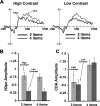Contralateral delay activity provides a neural measure of the number of representations in visual working memory
- PMID: 20147415
- PMCID: PMC2853266
- DOI: 10.1152/jn.00978.2009
Contralateral delay activity provides a neural measure of the number of representations in visual working memory
Abstract
Visual working memory (VWM) helps to temporarily represent information from the visual environment and is severely limited in capacity. Recent work has linked various forms of neural activity to the ongoing representations in VWM. One piece of evidence comes from human event-related potential studies, which find a sustained contralateral negativity during the retention period of VWM tasks. This contralateral delay activity (CDA) has previously been shown to increase in amplitude as the number of memory items increases, up to the individual's working memory capacity limit. However, significant alternative hypotheses remain regarding the true nature of this activity. Here we test whether the CDA is modulated by the perceptual requirements of the memory items as well as whether it is determined by the number of locations that are being attended within the display. Our results provide evidence against these two alternative accounts and instead strongly support the interpretation that this activity reflects the current number of objects that are being represented in VWM.
Figures




Similar articles
-
The contralateral delay activity as a neural measure of visual working memory.Neurosci Biobehav Rev. 2016 Mar;62:100-8. doi: 10.1016/j.neubiorev.2016.01.003. Epub 2016 Jan 21. Neurosci Biobehav Rev. 2016. PMID: 26802451 Free PMC article. Review.
-
Contralateral delay activity tracks the influence of Gestalt grouping principles on active visual working memory representations.Atten Percept Psychophys. 2015 Oct;77(7):2270-83. doi: 10.3758/s13414-015-0929-y. Atten Percept Psychophys. 2015. PMID: 26018644 Free PMC article.
-
Investigating the effects of perceptual complexity versus conceptual meaning on the object benefit in visual working memory.Cogn Affect Behav Neurosci. 2024 Jun;24(3):453-468. doi: 10.3758/s13415-024-01158-z. Epub 2024 Jan 30. Cogn Affect Behav Neurosci. 2024. PMID: 38291307
-
All identical objects reduce memory load at the late maintenance stage in working memory.Sci Rep. 2025 May 14;15(1):16700. doi: 10.1038/s41598-025-00433-4. Sci Rep. 2025. PMID: 40369027 Free PMC article.
-
Is the Contralateral Delay Activity (CDA) a robust neural correlate for Visual Working Memory (VWM) tasks? A reproducibility study.Psychophysiology. 2023 Feb;60(2):e14180. doi: 10.1111/psyp.14180. Epub 2022 Sep 19. Psychophysiology. 2023. PMID: 36124370 Free PMC article. Review.
Cited by
-
Impact of processing demands at encoding, maintenance and retrieval in visual working memory.Cognition. 2021 Sep;214:104758. doi: 10.1016/j.cognition.2021.104758. Epub 2021 May 10. Cognition. 2021. PMID: 33984741 Free PMC article.
-
Electrophysiological evidence for immature processing capacity and filtering in visuospatial working memory in adolescents.PLoS One. 2012;7(8):e42262. doi: 10.1371/journal.pone.0042262. Epub 2012 Aug 22. PLoS One. 2012. PMID: 22927923 Free PMC article.
-
Retroactive Attentional Shifts Predict Performance in a Working Memory Task: Evidence by Lateralized EEG Patterns.Front Hum Neurosci. 2018 Oct 18;12:428. doi: 10.3389/fnhum.2018.00428. eCollection 2018. Front Hum Neurosci. 2018. PMID: 30405380 Free PMC article.
-
Electrophysiological Signatures of Numerosity Encoding in a Delayed Match-to-Sample Task.Front Hum Neurosci. 2022 Jan 4;15:750582. doi: 10.3389/fnhum.2021.750582. eCollection 2021. Front Hum Neurosci. 2022. PMID: 35058763 Free PMC article.
-
Peak frequency in the theta and alpha bands correlates with human working memory capacity.Front Hum Neurosci. 2010 Nov 11;4:200. doi: 10.3389/fnhum.2010.00200. eCollection 2010. Front Hum Neurosci. 2010. PMID: 21206531 Free PMC article.
References
-
- Awh E, Barton B, Vogel EK. Visual working memory represents a fixed number of items regardless of complexity. Psychol Sci 18: 622–628, 2007 - PubMed
-
- Cavanagh P, Alvarez GA. Tracking multiple targets with multifocal attention. Trends Cogn Sci 9: 349–354, 2005 - PubMed
-
- Chafee MV, Goldman-Rakic PS. Matching patterns of activity in primate prefrontal area 8a and parietal area 7ip neurons during a spatial working memory task. J Neurophysiol 79: 2919–2940, 1998 - PubMed
-
- Courtney SM, Petit L, Maisog JM, Ungerleider LG, Haxby JV. An area specialized for spatial working memory in human frontal cortex. Science 279: 1347–1351, 1998 - PubMed
-
- Curtis CE, D'Esposito M. Selection and maintenance of saccade goals in the human frontal eye fields. J Neurophysiol 95: 3923–3927, 2006 - PubMed
Publication types
MeSH terms
LinkOut - more resources
Full Text Sources
Other Literature Sources
Medical

